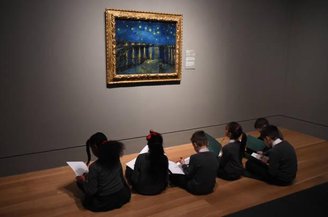Known worldwide for its iconic swirls, Vincent van Gogh’s “Starry Night” painting has always fascinated everyone with its fantastical representation of the sky with its explosion of shapes and colors. However, since the 2000s A new group has joined the experts: physicists.
A famous study published in 2006 suggested that the directions of energy flows represented by the Dutch artist’s lines could be linked to the physical concepts of turbulence, as if following Russian mathematician Andrei Kolmogorov’s so-called theory of turbulence from 1941. A more recent proposal, 50 years after the study.
Now, in a paper recently published in the journal Physics of Fluids, a team of researchers from China and France have revisited the theory. But unlike previous studies that examined the table in parts, this study examined all the vortices, or whirlpools, in the table as a whole, trying to discover what the authors are saying “latent turbulence”.
Turbulent sky in Van Gogh’s painting and Kolmogorov’s theory
Energy dissipation, a phenomenon we cannot see with our eyes, occurs in turbulent fluids according to Kolmogorov’s theory of turbulence. The mathematician says that energy at large scales is continuously transferred to smaller scales until it turns into heat at smaller scales.
Although clouds can reflect this constant activity, a proper understanding of atmospheric turbulence requires tools that can map these invisible movements. Turbulence theory provides statistics to understand these chaotic patterns. in atmospheric currents and liquid flows.
Unable to measure the turbulence of that magical night in 1889 at the Saint-Paul-de-Mausole mental hospital in France, a team of scientists led by physicist Yinxiang Ma from Xiamen University in China decided to measure the turbulence to check whether Van Gogh’s strokes were consistent with the Russian mathematician’s theory.
What do the brush strokes in Van Gogh’s painting reveal?

To test their hypothesis, the authors used a high-resolution digital image of the artwork to zoom in and examine in detail the brushstrokes on each of the 14 spirals and vortices. The analysis evaluated the movements suggested in the oil painting as follows: atmospheric turbulence signatures.
To check the correlation with the Kolmogorov scale, the team carefully examined spatial features, as well as the intensity of light reflected by the paint used in the painting. Van Gogh used a technique called impasto, in which paint is applied in thick, textured layers, creating a visibly embossed surface.
“The result shows that Van Gogh observed the actual flows very carefully, so that not only the sizes of the vortices/whirlpools in ‘Starry Night’ vary, but also their relative distances and densities. follow the physical law that governs turbulent flows“, concludes the study.
New unknown aspects of Van Gogh’s painting

Analysis of the smallest scales of the artist’s brushstrokes not only proved the relationship between Van Gogh’s painting and Kolmogorov’s theory, but also revealed another surprise: The picture is also consistent with the power spectrum of scalars, a theory proposed by Australian George Batchelor in 1959..
This mathematician created a model to describe the power spectrum of scalars, which are physical properties that show how the energy of a turbulent fluid is transferred from large scales of motion to small scales. This model complements Kolmogorov’s theory.
The researchers hope that future experimental studies of “Starry Night” will provide clues as to how the genius artist managed to capture the nature of turbulence. “It seems time to propose a new definition of turbulence that will encompass a wider range of situations,” the authors said in a statement.
Did you like the content? So stay up to date with more works like this on TecMundo and take the opportunity to share the article with your friends on social media. Until later!
Source: Tec Mundo
I’m Blaine Morgan, an experienced journalist and writer with over 8 years of experience in the tech industry. My expertise lies in writing about technology news and trends, covering everything from cutting-edge gadgets to emerging software developments. I’ve written for several leading publications including Gadget Onus where I am an author.












